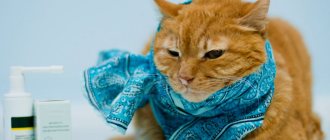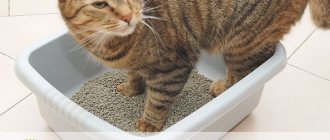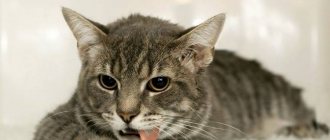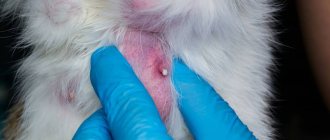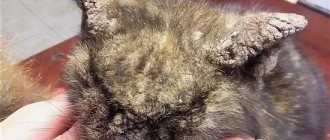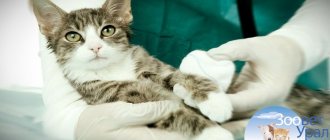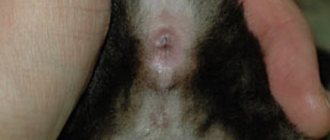Owners of cats can often observe their pets sneezing. This phenomenon can be single or multiple. Sneezing itself in animals has a protective function; its mechanism is exactly the same as in humans.
However, if this physiological process in a cat becomes regular, the owner needs to pay close attention to the health of his pet. If a cat sneezes, what should owners do? Detection of accompanying symptoms should prompt a visit to the veterinarian.
Why does a cat sneeze?
Sneezing in cats can be caused by unfavorable factors of various natures. For example, the sneeze reflex in animals is a reaction to the influence of any allergen that irritates the mucous membrane of the upper respiratory tract. The ingress of dust particles, pollen from flowering plants, and household chemicals irritate the receptors in the nasal mucosa, which is accompanied by sneezing.
The cat sneezes
Important! As a rule, sneezing in cats and other animals is caused by irritation of the nerve endings located on the mucous membrane of the respiratory tract.
Often, sneezing can be a symptom of a respiratory illness. A common runny nose, as a rule, is always accompanied by a reflexive sneezing reflex. Thus, the animal’s body clears the respiratory tract from accumulated exudate.
recommended articles:
- Pneumonia in cats
- Antiviral drugs for cats
Cats, cats, kittens sneeze when:
- asthma;
- colds;
- viral, bacterial, fungal infections;
- the presence of polyps in the nose;
- neoplasms in the respiratory tract, upper respiratory tract;
- severe hypothermia;
- congenital pathologies, anatomical defects in the structure of the respiratory organs;
- chronic respiratory diseases (tonsillitis, rhinotracheitis, sinusitis);
- the presence of foreign objects in the larynx.
The sneezing reflex in cats can be triggered by sharp, pungent odors, for example, perfume, eau de toilette, air freshener, tobacco smoke. Molds that live on wall surfaces, congenital pathologies, and anatomical defects of the respiratory tract organs provoke sneezing attacks in cats.
Once in the upper respiratory tract, allergens of various nature irritate the mucous membranes and lead to frequent sneezing. Sneezing and sniffling in cats are often signs of seasonal allergies.
Treating a runny nose at home
How to treat cat sneezing at home? First of all, you need to call a veterinarian or go with your animal to a veterinary clinic for an appointment. And a visit to a state veterinary clinic is not that expensive. If a cat is sneezing and has a small amount of snot, she will most likely be prescribed a draft-free apartment and wiping her nose with any disinfectant, such as chlorohexedine.
If, despite all this, the cat also has an elevated body temperature, she will need to undergo a course of antibiotics, which the doctor will prescribe for her.
You shouldn’t buy medicine yourself, since animals have their own medicines, and even if sometimes medicines from a human pharmacy are used, you need to be able to calculate the required dosage based on the weight and age of the cat. If the calculation is not made correctly, then severe complications may arise, and there is a possibility of kidney failure, and this is the certain death of the animal.
Therefore, you must strictly adhere to the prescriptions and advice of your veterinarian. Plus, your pet should always have clean, warm water available in an accessible place . If for some reason he cannot drink water during an exacerbation of the disease, he needs to fill it with a syringe without a needle. The daily fluid intake is approximately 700 ml.
Causes of snot
If sneezing is accompanied by a runny nose, mucous, and purulent discharge from the eyes, the symptoms do not go away within 7-10 days; rather, the reason for this condition lies in the development of infectious processes in the body of the pet. Sneezing, coughing, or rhinitis may indicate that your beloved cat is sick with parasitic, viral, or bacterial diseases.
One of the first manifestations of peritonitis, plague, calcivirosis, viral pneumonia, helminthic infestations, and other parasitic diseases is a runny nose, frequent sneezing, coughing, and serous-catarrhal discharge from the eyes.
The cat is sneezing, there is noticeable discharge from the eyes
A runny nose in cats, kittens, cats can occur against the background of allergic reactions, when foreign bodies or objects enter the respiratory tract. Nasal discharge can be: serous, catarrhal, purulent. In cases of chronic rhinitis, blood clotting disorders, and feline viral immunodeficiency, bloody threads, clots, and inclusions are noticeable in the discharge from the nose.
Who's in danger
Regardless of the reason for the absence of symptoms in an infected person, all people around him, especially those at risk, are at risk. Let's look at it with an example.
Even if an infected person has no symptoms, all the people around him are still at risk.
A young man “caught” the virus at work and brought it home. His children may get sick in a mild/asymptomatic form, but elderly parents and relatives with chronic diseases, especially diabetes, obesity, heart and vascular diseases have every chance of getting a detailed picture of the disease with serious consequences.
Infection can occur even if the older generation lives alone. They just brought their grandchildren for the weekend. In appearance, the children are completely healthy, so grandparents do not suspect anything that during hugs and games, children release viral particles into the air with saliva.
Therefore, it is so important to remember that the incubation period lasts 2-3 weeks. With an asymptomatic course, the release of the virus from the body when talking, coughing, sneezing can also last up to several weeks.
It is important to follow the rules of wearing a mask and washing your hands, even for seemingly healthy people. So they care first of all not only about themselves, but also about others.
What to do?
If your cat’s eyes are very watery, the general condition has worsened, and your pet begins to sneeze frequently, you should consult a veterinarian. The animal may have contracted an eye infection. In this case, it is necessary to treat the eyes with ophthalmic solutions, which can be purchased at a veterinary pharmacy, or rinse the eyes with decoctions of medicinal plants, for example, a warm infusion of chamomile flowers.
If your cat sneezes, snorts, or rubs his nose with his paw, there is most likely a foreign object in the nose. You can alleviate your pet's condition by using special tweezers or any other available means. All manipulations should be carried out extremely carefully so as not to hurt the cat or injure the mucous membrane.
The cat rubs its face with its paw
Having noticed mucous discharge from the nose, shortness of breath, difficulty breathing, swollen red eyes in a cat or kitten, it is necessary to establish the cause of this condition. Most likely, sneezing is caused by allergens. It is worth consulting with a veterinarian who will select a safe, most effective antihistamine.
Important! If blood or blood clots are released when sneezing, this may indicate the development of cancer or serious damage to the nasal passages.
Increased body temperature, enlarged submandibular lymph nodes, lethargy, decreased activity, refusal of food and treats, profuse nasal discharge are a serious cause for concern. Therefore, contact your veterinarian and take the cat to a veterinary hospital.
Fluffy patients with viral infections will be prescribed complex treatment, antibiotic therapy (Fosprenil, Maxidin), anti-inflammatory, antipyretic drugs. To normalize the general condition of furry purrs, vitamin complexes, mineral supplements, and immunomodulators will be prescribed.
Drops for the treatment of rhinitis
In case of a runny nose, the cat’s nasal passages are washed with hypotonic solutions, and the mucous membrane is irrigated with 0.5% tannin, galazolin, and thymogen.
If the sneezing reflex and snot are provoked by helminthic infestation, the cats will be prescribed effective helminthic drugs. For fungal infections - fungicidal, antifungal medications.
The veterinarian will prescribe effective treatment therapy
Sneezing caused by allergies is treated with antiallergic medications, special medicinal creams, and ointments. It is equally important to eliminate allergens from the cat’s external environment.
During treatment, owners must strictly follow all recommendations of the attending physician and provide the pet with the most comfortable living conditions. In case of respiratory diseases, it is absolutely unacceptable for the cat to be in a draft! Constantly remove discharge from the eyes and nose with sterile cotton-gauze swabs soaked in antiseptic solutions.
What not to do when treating a runny nose in a cat
There are situations when it is not possible to show a pet to a veterinarian due to remote residence. Then, when treating it, in no case should you use:
- Any drinks containing alcohol.
- Medicines intended for people, an exception may be if this is a recurrent disease and the veterinarian has already prescribed medicines for the animal with the full prescribed dosage of the drug.
- You cannot use herbal decoctions, as not all of them are useful for your pet and can cause severe poisoning.
I would like to add that a veterinarian is a specialist who can help a pet, and if it is not possible to go to a doctor, then there is such a service as a veterinarian visiting your home. After all, many animal lovers simply because of their age or illness cannot leave their home.
© shutterstock
A correct diagnosis will save the life of your beloved pet.
Prevention of respiratory diseases
Owners of furry pets must provide proper care for their pets. Nei should place the cat house in drafts, near heating appliances. You need to systematically examine the eyes, mouth, and nose of your favorite cat, especially if the animal walks freely on the street.
It is equally important to monitor the cleanliness of the air in the house, apartment, and indoor air humidity. To strengthen the immune system, if the cat is kept on a natural diet, to increase resistance, cats need to be given multivitamin preparations and mineral supplements.
We invite you to join our Zen channel and group on VKontakte or Odnoklassniki, where new articles for pet owners are published.
Similar articles:
- My cat has a nosebleed - what should I do?
- Inflammation of the lower lip in a cat
- Clear nasal discharge in cats
Preventive measures
Runny nose and sneezing can be prevented. The main thing is to notice changes in the cat’s behavior in time.
Vaccinating a cat at an early age is an effective method in the fight against future snot
The surest way to protect yourself is timely vaccination. It can eliminate runny nose and sneezing caused by complex infectious diseases.
And simple rhinitis against the background of a cold is already less dangerous. But nevertheless, it is worth protecting your cat from independent trips to the street and long gatherings near open windows.
The animal should have a warm corner at home. This could be a special house or an equipped place.
When should you see a doctor if you have a runny nose?
A runny nose can cause great discomfort, but most often it goes away on its own. For example, for a runny nose caused by a viral infection, the best “treatment” is plenty of fluids and rest, periodic rinsing of the nose with saline solution, limiting the use of vasoconstrictor drugs for several days, and humidifying the air in the room. If you have a runny nose associated with an exacerbation of seasonal allergies, you need to keep the windows closed, use air conditioning, try to reduce your time in the open air as much as possible, come in from the street, take a shower and change clothes. Seasonal allergy symptoms can be controlled with oral antihistamines and intranasal corticosteroids (nasal sprays that contain steroids). However, it is important to understand that only a physician can prescribe such medications (including over-the-counter medications), and the use of antihistamines and decongestants in children is age-restricted.
What should you absolutely not do?
Many pet owners prefer not to contact veterinarians or use special medications for animals, but to resort to traditional methods of treatment. Sometimes such experiments can end in failure.
Traditional health recipes are sometimes very dangerous, both for people and pets.
Even if you know the reason for the animal’s illness, you should not do the following manipulations:
- Pour alcohol-containing compounds (vodka, alcohol, ethanol mixtures, moonshine, extracts and tinctures of alcohol) into the animal’s nasal passages.
- Treat pets with medications that are intended for use on humans.
- Injecting too many medications into the nasal passages.
Types of colds
Most often, the causes of colds in cats are acute viral and bacterial infections such as herpes virus, calicivirus, bordetellosis, chlamydia, mycoplasmosis.
Herpes. Viral infection of cats.
The virus is practically unstable and persists for no more than 18 hours in the external environment. Transmission of the virus through contact and household contact. Animals become infected through close contact with each other through household objects, carriers, and cages. After infection, an acute period develops within 2-6 days. Symptoms appear: sneezing, copious mucopurulent discharge from the nose and eyes, breathing through the mouth, depression, fever, redness of the conjunctiva, dermatitis in the nose and eyes, ulcers in the mouth. As a complication, young and weakened cats may develop pneumonia.
On the 20th day, the symptoms subside and a latent period begins, when the cat is clinically healthy, does not release the virus into the external environment, but becomes a lifelong virus carrier. Following immunosuppressive medications, steroid therapy, or stress, the virus may reactivate and the cat may begin to exhibit mild clinical symptoms. Episodes of viral shedding occur in 50% of cats during relapse of the disease.
Feline calicivirus
Stable in the external environment for up to 10 days. Transmission of infection through contact and household contact. The acute period lasts 2-14 days, during which there is damage to the oral mucosa (ulcers and erosions), refusal to feed, and active salivation.
After 20 days, the cat becomes a chronic virus carrier; it will be clinically healthy, but will constantly shed the virus for several years. Since calicivirus has many strains of the virus, a cat that has had one can become infected and become ill with another type of calicivirus.
Chlamydia in cats
The pathogen is unstable in the environment and is transmitted by contact.
The incubation period is from 3 to 14 days. Clinical symptoms: bilateral conjunctivitis, in the acute form, mucopurulent discharge from the nose, sneezing. Isolation of the pathogen after clinical recovery takes several months.
Kittens aged 2 to 12 months are at risk; in cats over 5 years of age, infection is unlikely.
Bordetellosis
The virus is stable in the external environment for up to 10 days and can reproduce in natural bodies of water. Airborne transmission of infection. Accompanied by mucopurulent nasal discharge, sneezing, conjunctivitis. Complications may develop in the form of pneumonia, fever, shortness of breath, and hyporexia. After recovery, the cat continues to excrete the pathogen for several months.
Young kittens are at risk; they also have a high risk of rapid progression of the disease.
Mycoplasmosis
A secondary pathogen in the development of diseases of the upper respiratory tract, the disease itself cannot cause rhinitis. A lot of bacteria normally live in the nose; they can cause rhinitis, but they cannot be primary. Bacteria develop against the background of mucosal injury for any reason: viral damage, foreign body, tumor growth, etc. When an integral layer of mucous membrane is damaged, bacteria begin to actively multiply and cause purulent inflammation. Such rhinitis is secondary and diagnosis of the root cause is necessary.
